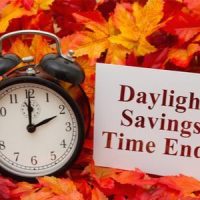Increased Danger Of Car Accidents When Daylight Savings Time Ends

On November 1, 2020, we set our clocks back an hour, ending daylight savings time. While you may have enjoyed the extra sleep that weekend, adjusting in the weeks afterwards can prove challenging. More sunlight in the early morning hours and an earlier nightfall can impact your sleep schedule as well as your driving abilities, making car accidents in Daytona Beach more likely to happen. Being aware of potential dangers can help to reduce your risks.
‘Falling Back’ An Hour Blamed For Spike In Car Accidents
On October 31, 2020, the American Automobile Association (AAA) issued an alert to drivers regarding the considerable dangers they face due to the end of daylight savings time. There is typically a spike in car accidents for weeks after the change, jeopardizing the safety of drivers and passengers, as well as bicyclists and pedestrians.
Our bodies are sensitive to sunlight, which provide valuable clues to our bodies that influence sleep schedules. During the spring, when we ‘spring forward’ to daylight savings time, there is a higher risk of heart attacks, strokes, and other serious health conditions. In the fall, the problem centers around drivers, who tend to be more accident prone. AAA reports that among the reasons for the annual spike in the car accident rate include:
- Increased glare from the sunrise during many drivers early morning commute;
- Having to drive home in the dark, which creates visibility issues for many people;
- Increased glare from headlights and street lamps, which can go on as early as 5:00 p.m.;
- Drowsy driving, which generally increases due to the earlier nightfall.
Reducing Your Risks While Adjusting To Time Changes
According to statistics from the National Institutes of Health (NIH), a disproportionate number of fatal car accidents occur after dark. In addition to visibility issues, slower reaction times and a greater tendency to get drowsy or distracted are to blame. Drivers, bicyclists, and pedestrians all need to be aware of the risks. Steps you can take to protect yourself include:
- Make it a point to continuing getting up and going to bed at your usual times;
- Be aware of how even subtle changes in your sleep schedule could impact your driving abilities;
- Watch for stretches of road or turns where sudden flashes of sunlight could be a problem;
- Avoid distractions at all times, but particularly when driving home after dark;
- Dim the lights on your dashboard, which can help to reduce glare;
- Avoid looking directly into other driver’s headlights, which can cause momentary blindness;
- Get your eyes examined regularly and consider anti-glare lenses;
- Speak to your doctor if you have significant problems with night blindness.
For bicyclists and pedestrians, take precautions to increase visibility, such as wearing light, bright colored clothing. Stick to sidewalks and bike lanes and cross only at designated intersections.
Reach Out to Us Today for Help
Despite your precautions, car accidents can still happen. At Bundza & Rodriguez, P.A., we help you get the compensation you need to recover. To request a consultation, contact our Daytona Beach car accident attorneys online today.
Resource:
journal-advocate.com/2020/10/31/aaa-alert-daylight-switch-increases-crash-risk/
https://www.daytonalawyers.com/night-time-car-accidents-drugs-alcohol-drowsy-driving-increase-risks/
